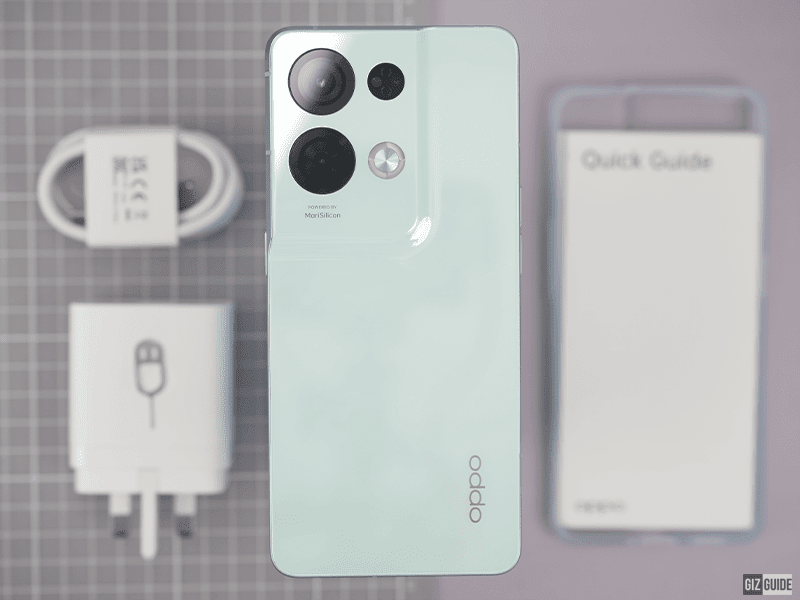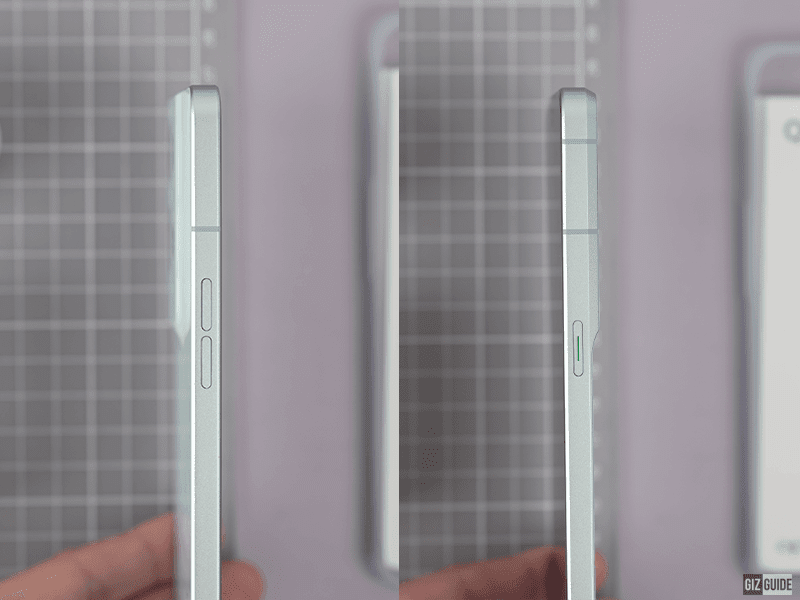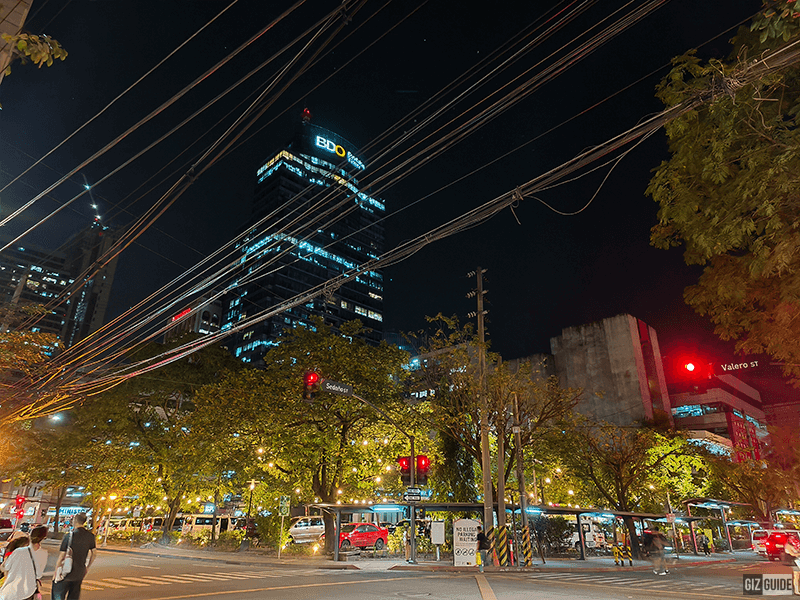Meet OPPO Reno8 Pro 5G!
The Global Chinese manufacturer recently added the OPPO Reno8 Pro 5G to the existing Reno8 series lineup for the Philippine market.
To recap, the new Pro variant comes with a 120Hz Flexible AMOLED FHD+ screen. Inside is the 5nm MediaTek Dimensity 8100-Max octa-core processor, MariSilicon X NPU, Mali-G610 MC6 GPU, LPDDR5 RAM, UFS 3.1 storage, and a 4,500mAh battery with 80W SUPERVOOC charging.
At the back is a triple rear camera set-up while in front is the 32MP f/2.4 selfie camera with the Sony IMX709 RGBW sensor.
In the Philippines, the smartphone is available thru Globe's GPlan 1499.
 |
| Packaging |
Let's unbox it first.
The OPPO Reno8 Pro 5G comes in familiar teal packaging with white and black accent colors. Around the box are the branding, key features and specs, and regulatory information.
 |
| Box inclusions |
Inside the box are the phone, SIM ejector tool, USB-C cable, 80W charger, silicone case, and documentation.
 |
| Back design |
At first glance, the phone is near flagship grade in terms of materials used, design, and fit and finish.
Near flagship-grade materials!
Upon closer inspection, the phone is made of a glass front, metal frame, and glossy glass back panel.
The metal frame comes with a rough texture and with chamfered edges. This makes the phone easier to hold while reducing the phone's slipperiness. It also significantly improves the structural strength of the phone.
 |
| Display |
As mentioned above, the front 6.7-inch Flexible AMOLED screen with a 120Hz refresh rate, a 360Hz touch sampling rate, and a 2412 x 1080 resolution. It is protected by Gorilla Glass 5.
Around the phone are super slim side bezels with slightly thicker top and bottom bezels. On the upper part of the phone is the punch hole where the selfie cam is.
Images produced by the panel are bright, sharp, detailed, and vibrant. To maintain the high refresh rate, the panel has to be super bright, and unsurprisingly, it is super readable under direct sunlight.
 |
| Top and bottom |
On top are the microphone ports while at the bottom are the SIM tray, microphone port, USB-C, and speaker grill.
 |
| Left and right sides |
On the left side of the phone are antenna lines and the volume buttons while on the right are more antenna lines and the power button.
 |
| Rear cameras |
At the back is the aforementioned triple rear camera set-up setup made of the 50MP f/1.8 primary camera with Sony IMX766 with All-Pixel Omni-Directional PDAF, 8MP f/2.2 119-degree ultra-wide camera and 2MP f/2.4 4cm macro camera with an LED flash.
The stock camera app features the following modes: Photo, Video, Night, Portrait, Pano, Slo-Mo, Sticker, Extra-HD, Movie, Dual-View Video, Pro, Macro, Time-lapse, and Text scanner.
The Pro mode allows control for White Balance, Focus, Shutter Speed (30 secs - 1/8000), ISO (100-6400), and EV (+-2).
First Camera Samples
 |
| Daylight 1x |
 |
| Daylight ultra-wide |
 |
| Close-up |
 |
| Indoor 1x |
 |
| Indoor ultra-wide |
 |
| Lowlight 1x |
 |
| Lowlight Ultra-wide |
 |
| Night mode 1x |
 |
| Night Mode ultra-wide |
Across daylight, indoors, and low light, the primary rear camera is able to produce sharp, detailed images with vibrant color and good contrast. One minor nitpick is that light sources or bright areas tend to overexpose.
What needs improvement is the ultra-wide camera where images are softer compared to similarly spec ultra-wide cameras. In addition to that, the white balance is almost always a miss. Even the night mode from the ultra-wide is washed out.
The 32MP f/2.4 front-facing camera with Sony IMX709 RGBW sensor features 0.8x, 1x, and 2x modes which make it unique. The camera app crops into the 32MP to achieve the 2x while the 0.8x uses the full width of the sensor.
Selfie camera modes include Photo, Video, Night, and Portrait.
 |
| Daylight selfie |
 |
| Indoor Selfie |
 |
| Portrait Selfie |
 |
| Lowlight selfie |
 |
| Night selfie |
The Selfie camera has a high-resolution sensor that allows the software to offer three different field-of-views (0.8x, 1x, 2x). This is just from one camera, the software just captures different sizes of it.
All of the selfies are sharp and detailed with good contrast. It does however struggle with white balance. This is most apparent with skin tones.
Overall, for the price, the camera's performance is underwhelming since it uses Sony sensors that perform better with competing phones. OPPO has to further refine the MariSilicon Image Processor. This may take some time as we've seen from other brands.
Performance
 |
| AnTuTu and GeekBench |
We ran some benchmarks like the Antutu where we got a score of 733,659. While on Geekbench we got 896 points on the single core and 3,493 on the multi-core tests.
 |
| Wild Life Extreme and CPDT |
In 3DMark Wild Life Extreme the phone managed to score 1,501 overall and scored 9 average FPS. While si CPDT scored 653.17 MB/s in sequential write speeds and it scored 570.66 MB/s in sequential read speeds.
In real-life use, the phone runs smoothly. There were barely any hiccups. Navigating thru the UI, and opening or switching between apps is instantaneous without a noticeable slowdown or stuttering.
The 4,500mAh battery managed to last for 6 hours in our usual YouTube Video loop test. While the 80W charging brick charges the Reno8 Pro 5G from 10 percent to 100 percent in under 45 minutes from our experience.
The earpiece and the bottom-firing speakers produce a stereo experience. However, depending on the media, the bottom tends to produce the more powerful sound. It is still better than a single-channel speaker as the stereo provides a wider sound stage and direction. The sound produced has good clarity and separation but the maximum volume could be louder as most smartphones with similar pricepoint with stereo speakers are normally louder in volume.
The in-display fingerprint reader and Face Unlock are easy and quick to set up. Once set up, both detect our face and our fingerprint immediately unlock the phone. The camera struggles when the environment is dark or when we are wearing a mask. The screen brightens up to compensate for dark situations
For connectivity, 5G, VoLTE, WiFi, Bluetooth, and NFC works consistently and as expected.
The Reno8 Pro 5G is running on Android 13-based ColorOS 13.0. It is familiar and easy to use. It adds the new features of Android 13 with minor visual and UI changes. If you liked ColorOS before, then you will like it. If you didn't like ColorOS before, this will probably not change your mind.
 |
| Web surfing |
OPPO Reno8 Pro 5G Specs
Display: 6.7-inch Gorilla Glass 5 protected Flexible AMOLED screen w/ 120Hz refresh rate, 360Hz touch sampling rate, FHD+ 2412 x 1080 resolution at 394ppiCPU: 2.85GHz 5nm MediaTek Dimensity 8100-Max octa-core processor + MariSilicon X NPU
GPU: Mali-G610 MC6
RAM: 8GB/12GB LPDDR5
ROM: 256GB UFS 3.1
Back Camera: 50MP f/1.8 Sony IMX766 w/ All-Pixel Omni-Directional PDAF + 8MP f/2.2 119-degree ultra-wide-angle w/ EIS + 2MP f/2.4 4cm macro + LED flash
Selfie Camera: 32MP f/2.4 Sony IMX709 RGBW
Battery: 4,500mAh w/ 80W SUPERVOOC
OS: Android 12 w/ ColorOS 12.1
Connectivity: WiFi 6 2x2 MIMO 8 Spatial-stream sounding MU-MIMO, 5G, 4G LTE, Bluetooth 5.3 (SBC, AAC, aptX HD, LDAC), OTG, NFC, GPS, A-GPS, GLONASS, BeiDou, QZSS, Galileo, dual SIM
Sensors: Accelerometer, light, orientation, proximity, gyroscope, sound, magnetic
Others: In-Display fingerprint sensor, Ultra-Conductive Cooling System, X-axis linear motor, USB-C, Colors: Glazed Black, Glazed Green
Dimensions: 161.2 x 74.2 x 7.34 mm
Weight: 183 g
Price: GPlan 1499 (12GB/256GB)
Quick thoughts
Exclusive to the GPlan 1499, the Reno 8 Pro 5G offers great specs for the price on paper but with varying results in performance in different categories.
We love the 120Hz Flexible AMOLED FHD+ screen that produces bright, vibrant, and sharp images. The panel is responsive and we never felt like the phone slowed down or misread our taps or gestures.
The phone's performance is also good across benchmarks and daily use.
The 4,500mAh battery may be smaller compared to some of its contemporary but the 80W charging mode then makes up for it. Do not get us wrong, the battery does last but there are longer-lasting phones out there.
Our only concern with the phone is that even though the phone is equipped with great-performing camera sensors, the MariSilicon still needs to improve to take advantage of the said sensors.
Otherwise, the OPPO Reno8 Pro 5G could be a compelling option for Globe Postpaid users on a budget.
What do you guys think?














































Post a Comment